Market Size of Aircraft Carrier Ship Industry

| Study Period | 2019 - 2029 |
| Market Size (2024) | USD 1.23 Billion |
| Market Size (2029) | USD 2.25 Billion |
| CAGR (2024 - 2029) | 12.75 % |
| Fastest Growing Market | North America |
| Largest Market | North America |
Major Players
*Disclaimer: Major Players sorted in no particular order |
Aircraft Carrier Ship Market Analysis
The Aircraft Carrier Ship Market size is estimated at USD 1.23 billion in 2024, and is expected to reach USD 2.25 billion by 2029, growing at a CAGR of 12.75% during the forecast period (2024-2029).
The increasing geopolitical issues and territorial disputes between various nations led to the procurement of aircraft carrier ships, which can be attributed to the growth of the market. Also, the increasing investments in replacing the existing fleet with newer generation carrier ships will accelerate market growth. Aircraft carrier ships may continue operations for several years by providing strength to the naval forces. However, the high maintenance costs associated with such ships shall prove to be a restraint for various regions. Asia-Pacific is one of the global hotspots for military conflicts. The increasing number of territorial issues in the region propelled the countries to procure advanced aircraft carrier ships.
Aircraft Carrier Ship Industry Segmentation
An aircraft carrier is a warship that serves as a seagoing airbase, equipped with a full-length flight deck and used for carrying, arming, deploying, and recovering aircraft.
The aircraft carrier market is segmented by type, technology, configuration, and geography. By type, the market is segmented into amphibious assault ships, helicopter carriers, and fleet carriers. By technology, the market is segmented into conventional-powered and nuclear-powered. By configuration, the market is classified into Catapult-assisted Take-off Barrier Arrested Recovery (CATOBAR), Short Take-off but Arrested Recovery (STOBAR), and Short Take-off but Vertical Recovery (STOVL). The report also covers the market sizes and forecasts for the aircraft carrier ship market in major countries across different regions. For each segment, the market size is provided in terms of value (USD).
| Type | |
| Amphibious Assault Ship | |
| Helicopter Carrier | |
| Fleet Carrier |
| Technology | |
| Conventional Powered | |
| Nuclear Powered |
| Configuration | |
| Catapult-assisted Take-off Barrier Arrested-recovery (CATOBAR) | |
| Short Take-off but Arrested Recovery (STOBAR) | |
| Short Take-off but Vertical Recovery (STOVL) |
| Geography | |||||||
| |||||||
| |||||||
| |||||||
| Rest of the World |
Aircraft Carrier Ship Market Size Summary
The aircraft carrier ship market is poised for significant growth over the forecast period, driven by increasing geopolitical tensions and the need for advanced naval capabilities. The market is experiencing a shift towards the procurement of newer generation carrier ships, which are expected to enhance the operational strength of naval forces. Despite the high maintenance costs associated with these vessels, the demand remains robust, particularly in regions like Asia-Pacific, where territorial disputes are prevalent. The nuclear-powered segment is anticipated to lead the market due to its advantages in endurance and capacity, offering greater space for aviation fuel and ordnance. Collaborations between shipbuilding companies and system manufacturers are expected to further propel the development of advanced aircraft carriers with reduced maintenance costs.
North America is projected to witness the highest growth in the aircraft carrier ship market, fueled by substantial defense spending and research and development investments. The US Navy's expansion plans, including the procurement and modernization of aircraft carriers, are central to this growth. The market is characterized by a consolidated nature, with key players such as NAVANTIA SA, BAE Systems plc, and Huntington Ingalls Industries, Inc. playing significant roles. These companies engage in long-term contracts with governments and participate in public-private partnerships, particularly in the Asia-Pacific region, to support aircraft carrier construction. The ongoing and upcoming procurement, maintenance, and modernization programs are expected to bolster the growth strategies of these companies, ensuring a dynamic market landscape.
Aircraft Carrier Ship Market Size - Table of Contents
-
1. MARKET DYNAMICS
-
1.1 Market Overview
-
1.2 Market Drivers
-
1.3 Market Restraints
-
1.4 Porter's Five Forces Analysis
-
1.4.1 Bargaining Power of Suppliers
-
1.4.2 Bargaining Power of Buyers/Consumers
-
1.4.3 Threat of New Entrants
-
1.4.4 Threat of Substitute Products
-
1.4.5 Intensity of Competitive Rivalry
-
-
-
2. MARKET SEGMENTATION
-
2.1 Type
-
2.1.1 Amphibious Assault Ship
-
2.1.2 Helicopter Carrier
-
2.1.3 Fleet Carrier
-
-
2.2 Technology
-
2.2.1 Conventional Powered
-
2.2.2 Nuclear Powered
-
-
2.3 Configuration
-
2.3.1 Catapult-assisted Take-off Barrier Arrested-recovery (CATOBAR)
-
2.3.2 Short Take-off but Arrested Recovery (STOBAR)
-
2.3.3 Short Take-off but Vertical Recovery (STOVL)
-
-
2.4 Geography
-
2.4.1 North America
-
2.4.1.1 United States
-
2.4.1.2 Canada
-
-
2.4.2 Europe
-
2.4.2.1 Germany
-
2.4.2.2 United Kingdom
-
2.4.2.3 France
-
2.4.2.4 Russia
-
2.4.2.5 Rest of Europe
-
-
2.4.3 Asia-Pacific
-
2.4.3.1 India
-
2.4.3.2 China
-
2.4.3.3 South Korea
-
2.4.3.4 Japan
-
2.4.3.5 Rest of Asia-Pacific
-
-
2.4.4 Rest of the World
-
-
Aircraft Carrier Ship Market Size FAQs
How big is the Aircraft Carrier Ship Market?
The Aircraft Carrier Ship Market size is expected to reach USD 1.23 billion in 2024 and grow at a CAGR of 12.75% to reach USD 2.25 billion by 2029.
What is the current Aircraft Carrier Ship Market size?
In 2024, the Aircraft Carrier Ship Market size is expected to reach USD 1.23 billion.

